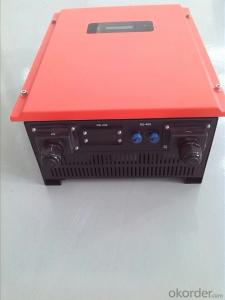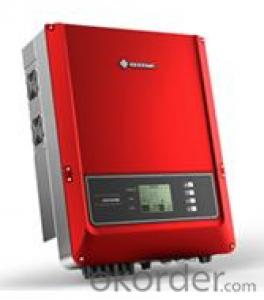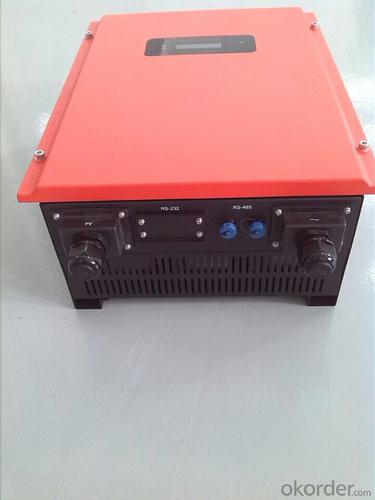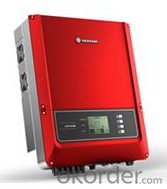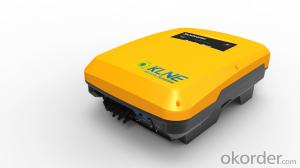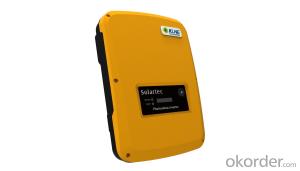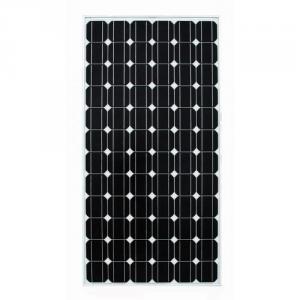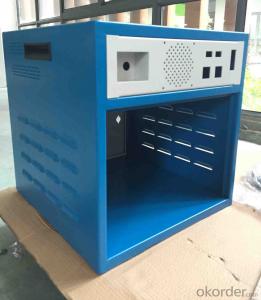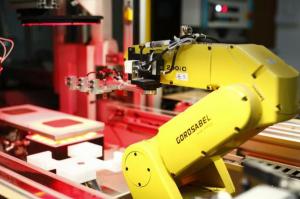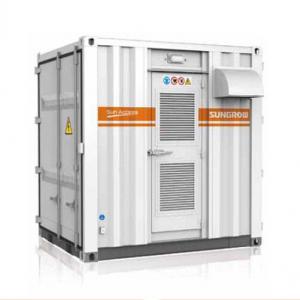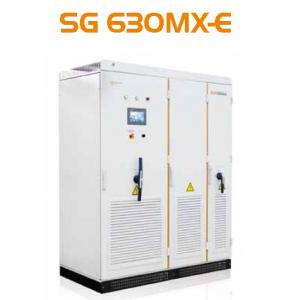Uno Solar Inverter Off Grid Type Solo-10000S
- Loading Port:
- Shanghai
- Payment Terms:
- TT OR LC
- Min Order Qty:
- 10 unit
- Supply Capability:
- 1000 unit/month
OKorder Service Pledge
OKorder Financial Service
You Might Also Like
Product Description:
This system can keep 10 energy-saving bulbs with 15W working for 5 hours per day and a 5W radio working for 8 hours a day. The AC load can keep a 33in color TV (90W) working for 5 hours, a 70W phonograph record machine working for 5 hours, a 200L fridge (180W) working for a whole day, a fan less than 60W running for 5 hours, a 300W computer working for 4 hours, two 100W laptops working for 5 hours, a 1000W water heater running for 1 hours, a 2000W electric stove working for 2 hours, and another 1000W appliance running for 3 hours.
It can work for 3 successive rainy days.
● System voltage:220V
● Output:220VAC/50Hz
● Power: 11000VA
● Dimensions of the box: 600 X 2000 X 600mm
● Net weight: 400kg
Product Datasheet:
Main Accessories | Specifications | No. | Notes |
Inverter | Solo-10000 | 1 | Standard |
PV modules | Polysilicon 100Wp | 68 pieces | Optional |
Storage battery | Lead acid, maintenance-free,2V/400Ah | 110 pieces | Optional |
Controller | Solo-VS220V/50A | 1 unit | Optional |
PV accessories shelf | customized | 1 set | Optional |

Product Advantages:
Powered by DC current
Can used out of doors
High effiency and low noise
FAQ
What is your payment terms?
We accept T/T payment, normally we need 20% T/T in advance, 80% payed before shipment.
What is your packing system?
We put the sistem in the wooden box.
Can you do OEM service?
Yes we can, but we need to do it with a certain order quantity.
- Q: How do you choose the right size of solar inverter for a solar power system?
- To choose the right size of solar inverter for a solar power system, you need to consider two main factors: the total power output of your solar panels and the maximum power consumption of your household or facility. First, calculate the total wattage of your solar panels by summing up the individual panel ratings. Then, assess your power consumption by considering the peak load requirements or the average daily consumption. Match the inverter's capacity to the higher value among these two factors to ensure efficient energy conversion. It is also recommended to consult with a professional solar installer to ensure the correct sizing of the inverter based on your specific needs.
- Q: Can a solar inverter be used in areas with high levels of electrical noise or interference?
- In areas with high levels of electrical noise or interference, a solar inverter can indeed be utilized. However, it is crucial to verify that the solar inverter is specifically designed and equipped to handle such conditions. Some contemporary solar inverters come with built-in features and technologies that aid in minimizing electrical noise and interference. These features encompass advanced filtering, shielding, and surge protection mechanisms. In addition, employing proper grounding and installation techniques can further diminish the impact of electrical noise and interference on the solar inverter's performance. To ensure compatibility and optimal performance in high-noise environments, it is recommended to seek advice from a professional or the manufacturer of the solar inverter.
- Q: What is the efficiency rating of a solar inverter?
- The efficiency rating of a solar inverter refers to the percentage of solar energy that is converted into usable electricity. It indicates how effectively the inverter can convert the direct current (DC) power generated by solar panels into alternating current (AC) power for use in homes or businesses. Higher efficiency ratings mean less energy loss during the conversion process, resulting in more electricity being available for consumption.
- Q: Can a solar inverter be used in a mobile or portable solar system?
- Yes, a solar inverter can be used in a mobile or portable solar system. In fact, it is a crucial component that converts the direct current (DC) generated by the solar panels into alternating current (AC) that can be used to power various devices and appliances. Portable solar systems often include a built-in inverter, allowing them to provide convenient and clean energy on the go.
- Q: What is the maximum DC input current that a solar inverter can handle?
- The maximum DC input current that a solar inverter can handle depends on the specifications and capabilities of the specific model. It can vary significantly, ranging from a few amperes to several hundred amperes, based on factors such as the power rating and design of the inverter.
- Q: Can a solar inverter be used in areas with unstable grid connections?
- Yes, a solar inverter can be used in areas with unstable grid connections. Solar inverters are designed to handle fluctuations and interruptions in the grid power supply. They typically have built-in features such as anti-islanding protection and grid support functionalities that ensure safe operation even in areas with unreliable grid connections. These inverters can switch seamlessly between grid power and solar power, providing a consistent power supply to the connected loads in such areas.
- Q: How much maintenance is required for a solar inverter?
- Solar inverters require regular maintenance to ensure optimal performance and longevity. The frequency and level of maintenance may vary depending on the specific make and model of the inverter, as well as environmental factors. Generally, maintenance tasks include regular cleaning to remove dust and debris, checking and tightening electrical connections, inspecting for any signs of wear or damage, and updating software or firmware as needed. It is recommended to follow the manufacturer's guidelines and have a professional solar technician perform periodic maintenance to maximize the efficiency and reliability of the solar inverter.
- Q: Can a solar inverter be used in regions with high humidity or moisture levels?
- Yes, solar inverters can be used in regions with high humidity or moisture levels. However, it is important to ensure that the inverter is designed and rated for such conditions. The inverter should have adequate protection against moisture, such as being IP65 rated or higher, to prevent any damage or malfunctions due to humidity or moisture.
- Q: Can a solar inverter be used in a smart grid system?
- Yes, a solar inverter can be used in a smart grid system. In fact, solar inverters play a crucial role in integrating renewable energy sources, such as solar power, into a smart grid. They convert the direct current (DC) generated by solar panels into alternating current (AC) that can be used to power homes and businesses. Additionally, smart grid systems utilize advanced communication and control technologies to manage and optimize the flow of electricity, enabling solar inverters to interact with the grid and provide real-time data on energy generation and consumption. This integration helps increase the efficiency, reliability, and overall performance of the smart grid system.
- Q: What is the role of a cooling system in a solar inverter?
- The role of a cooling system in a solar inverter is to regulate and dissipate heat generated during the conversion of DC power from solar panels to AC power for use in homes or businesses. By maintaining optimal operating temperatures, the cooling system ensures the inverter's components do not overheat, which could lead to reduced efficiency, performance degradation, or even system failure.
Send your message to us
Uno Solar Inverter Off Grid Type Solo-10000S
- Loading Port:
- Shanghai
- Payment Terms:
- TT OR LC
- Min Order Qty:
- 10 unit
- Supply Capability:
- 1000 unit/month
OKorder Service Pledge
OKorder Financial Service
Similar products
Hot products
Hot Searches
Related keywords
